|
|
|
Sort Order |
|
|
|
Items / Page
|
|
|
|
|
|
|
| Srl | Item |
| 1 |
ID:
128788
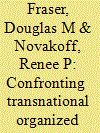

|
|
|
| 2 |
ID:
115401
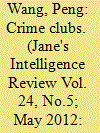

|
|
|
| 3 |
ID:
086192
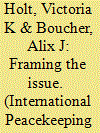

|
|
|
|
|
| Publication |
2009.
|
| Summary/Abstract |
This article examines the links between peace operations and combating transnational organized crime. It argues that while UN Security Council mandates direct UN missions to support establishing the rule of law in states that host peace operations, their role in addressing organized crime is more implicit than explicit. This article notes, however, that UN panels of experts, small fact-finding teams appointed to monitor targeted sanctions, may offer insight into, and options for addressing, such criminal networks. Panel findings and recommendations, however, are not integrated with related UN efforts to build the rule of law. This lack of integration reflects a need, on the part of the UN and its member states, to address better the ability of peace operations, UN panels of experts, and other tools for peacebuilding to contribute more effectively to fighting spoiler networks and organized crime.
|
|
|
|
|
|
|
|
|
|
|
|
|
|
|
|
| 4 |
ID:
179963
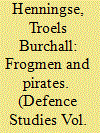

|
|
|
|
|
| Summary/Abstract |
What role can special operations forces (SOF) play against for-profit, illicit networks in operations with strict rules of engagement? How can small states utilize their SOF units to add value to a military strategy in cases where they take an active role in multinational operations? Based on in-depth interviews with members of maritime SOF units, commanding officers, and archival research, this article unearths the roles that Danish and Dutch maritime SOF units played against Somali piracy networks. Specifically, it analyses how SOF units were able to evolve their tactics, which allowed the international naval task forces to target the piracy networks’ increasingly sophisticated operations. Moreover, the article discusses other potential ways SOF units can influence for-profit, illicit networks. The case study sheds light on an aspect of the utility of SOF often overlooked in the literature, namely the ability to use discriminate and proportional violence in operations that straddle the categories of peace and war. This almost mundane use of SOF units is of special interest in relation to small states, who may take on leadership roles if they are willing to engage in the development of the operational concepts.
|
|
|
|
|
|
|
|
|
|
|
|
|
|
|
|
| 5 |
ID:
092459


|
|
|
|
|
| Publication |
2009.
|
| Summary/Abstract |
The UK intelligence system is engaged in three distinct roles - producing strategic assessments in the traditional way; acting as a 'global policeman' by monitoring terrorist and criminal networks; and raising the capability of other countries to defeat terrorist and insurgency groups. Counter-intuitively, it is perhaps the first role that is most questionable. The use of single source intelligence reporting, drawn from individuals selected principally for their willingness to share secrets, may not be the best way to analyse emerging issues such as climate change, energy security and financial stability. The Joint Intelligence Committee (JIC) may be drawing on too narrow a range of reporting to compete with increasingly sophisticated assessments from the private sector, academia and NGOs. In any event, the JIC has less impact on policy than is often imagined. The second task of 'global networker' is better-suited to the intelligence community's ability to combine human intelligence with communications intelligence and bulk data gathering, and is producing results. The third task of helping other countries to enforce the law and resist insurgency is proceeding on an ad hoc basis with occasional successes, but requires co-ordination across Whitehall so that improvements in the capabilities of other countries' intelligence services are accompanied by improved police and justice systems and enhanced oversight. Joint Intelligence Committee perhaps ought to be a Joint Action Committee.
|
|
|
|
|
|
|
|
|
|
|
|
|
|
|
|
| 6 |
ID:
099155
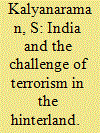

|
|
|
|
|
| Publication |
2010.
|
| Summary/Abstract |
Terrorism in the Indian hinterland is the result of a complex set of inter-related factors. The development of a jihad culture in Pakistan during the course of the Afghan conflict in the 1980s led to the subsequent Pakistani decision to employ jihad against India as a strategy. The mobilisation of the Hindu Right in India and ensuing communal violence led to the radicalisation of Muslim youth and the resort to terrorism by both Indian Islamists and Muslim criminal networks with help from Pakistan. Terrorist attacks by Pakistani jihadists and Indian Islamists, in turn, radicalised elements within the Hindu Right and set the stage for their turn towards terrorism in the last few years.
|
|
|
|
|
|
|
|
|
|
|
|
|
|
|
|
| 7 |
ID:
102084


|
|
|
|
|
| Publication |
2011.
|
| Summary/Abstract |
A well-known finding of research on illegal markets is that drug-dealing organisations operate in risky and uncertain market and intra-organisational conditions that considerably limit their size and their survival time. Yet, little is known about the organisations or individual dealers who are more successful than others at avoiding arrest and incarceration, especially in regard to dealers operating in groups of various sizes. This article proposes to fill this gap in the literature by fitting a Cox proportional hazard model to 'time to failure' data in a sample of 112 incarcerated male inmates who were active as drug dealers in the 3 years preceding their incarceration. The results show that organisational size is unrelated to survival. Instead, the size of dealers' core criminal networks emerged as a key factor in increasing survival in the drug trade. Other results indicate that involvement in markets for certain drugs (cocaine) is more risky than others (cannabis) and that hard drug users are arrested faster than others.
|
|
|
|
|
|
|
|
|
|
|
|
|
|
|
|
| 8 |
ID:
131809
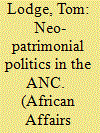

|
|
|
|
|
| Publication |
2014.
|
| Summary/Abstract |
Following Jacob Zuma's ascension to the presidency in South Africa, the African National Congress (ANC) has been dogged by rumours of escalating corruption and the personalization of power. This article documents these trends and explores three ways of understanding neo-patrimonialism in South Africa's ruling party. First, the article addresses the possibility that such political habits have a long history within the ANC but were restricted during its years in exile and have begun to resurface now that the armed struggle is over. Second, it considers explanations that relate to the party's historical ties to criminal networks and pressures arising from the transition to majority rule and contemporary electoral politics. Finally, the article investigates whether neo-patrimonialism is a reflection of broader tendencies within South African political and economic life. All three factors are found to have played a role in the rise of neo-patrimonial politics, and it is the confluence of these trends that explains why these dynamics have taken such a strong hold on the party.
|
|
|
|
|
|
|
|
|
|
|
|
|
|
|
|
| 9 |
ID:
102141


|
|
|
| 10 |
ID:
116343
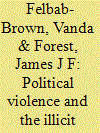

|
|
|
|
|
| Publication |
2012.
|
| Summary/Abstract |
This comparative analysis draws on field research in several West African countries to illustrate the dynamic relationships between political violence and organized crime in this sub-region. These relationships are often transactional, and almost always on a temporary basis. While some alliances of convenience may be forged, in other cases an adversarial relationship exists between organized crime and terrorist networks. In some cases, key actors within West African governments have benefited from these relationships. We then examine recent policies and strategies pursued by the U.S. and the international community that, in the name of combating terrorism, seek to constrain the illicit economies of the region, but in doing so may do more harm than good. The article concludes with some policy recommendations based on this analysis.
|
|
|
|
|
|
|
|
|
|
|
|
|
|
|
|
| 11 |
ID:
112616
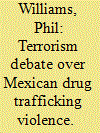

|
|
|
|
|
| Publication |
2012.
|
| Summary/Abstract |
Violence in Mexico related to drug trafficking has expanded enormously, and observers have begun using terms like terrorism, nacro-terrorism, and criminal insurgency to label the violence. However, arguments that Mexico is the victim of growing terrorism are both exaggerated and unconvincing. While there have been many murders of innocent civilians, these killings do not seem to have been motivated by a political, ideological, or religious cause. This analysis seeks to understand the nature of the expanding violence in Mexico. It starts from the premise that the violence is a complex and multi-layered phenomenon with a variety of different rationales and motivations. From this perspective, a pyramidal approach to the violence can be identified. At the base of the pyramid is the notion of drug-related violence as the medium of rational strategic competition in a highly lucrative illicit market. A second layer in the pyramid emphasizes factionalism within the organizations as well as a process of contracting out for much of the violence to youth gangs and specialists. And a third perspective on the violence puts less emphasis on organizations and more on the degeneration of norms and inhibitions.
|
|
|
|
|
|
|
|
|
|
|
|
|
|
|
|
| 12 |
ID:
112617


|
|
|
|
|
| Publication |
2012.
|
| Summary/Abstract |
Drawing from interviews, surveys, and other forms of research conducted in Lebanon, Gaza and the West Bank, and Mexico, this article compares Mexican cartels to Hamas and Hezbollah. The similarities between them are striking: these are all by necessity territorially specific organizations tied to relatively defined geographic locations, and have deep and sophisticated relationships with the states within which they operate. However, there are critical differences between Mexican drug cartels and Hamas and Hezbollah as well, the most important (according to an analysis of multiple definitions of terrorism) being the presence of political and ideological motivations. This analysis illustrates the conceptual challenges and classificational ambiguity involved in analyzing terrorism and organized crime.
|
|
|
|
|
|
|
|
|
|
|
|
|
|
|
|
| 13 |
ID:
087461


|
|
|
|
|
| Publication |
2009.
|
| Summary/Abstract |
We develop a theory of optimal networks in the context of criminal organizations. In this framework the criminals choose their network links with others according to a set of specified costs and benefits to participation. The optimal number and configuration of links within each network is solved for a set of 10,000 parameter simulations specifying the direct cost of links between agents, the benefit to connections, and the cost of being in the network with others. In addition, agents determine the size of the optimal network. This framework allows consideration of a variety of crime policy scenarios. In particular, removing the 'key player', the best strategy when the network is exogenous, may not be the optimal strategy in an environment in which the agents can change the size and structure of the network endogenously. More generally, optimal crime policy may be different if the criminals are aware of the policing strategy and can alter their network.
|
|
|
|
|
|
|
|
|
|
|
|
|
|
|
|
|
|
|
|
|